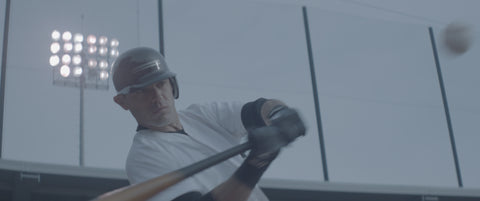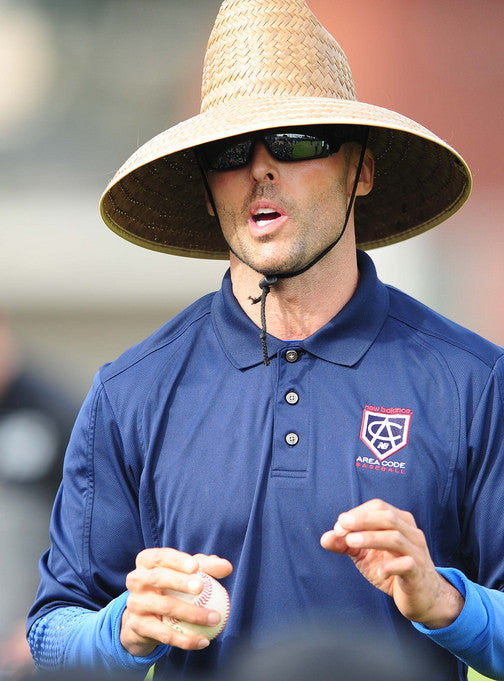The mindset of the Hitter; The Hunter VS. The Hunted.
THE HUNTER
The dominate hitter is “The Hunter!” The Hunter hits with a weapon, he’s proactive, confident, hungry, determined to eat! He’s on offense, in pursuit, ready to ambush, ready to ATTACK! The Hunter Plans the Hunt and then Hunts the Plan, waiting in the weeds like a Tiger waiting for a gazelle. The Hunter loads his swing with prepared eyes, in full anticipation of the pitch and location he is hunting, 100% on-time, with his “A+” swing!
THE HUNTED
The struggling hitter is “The Hunted!” The Hunted hits with a shield, he’s reactive, uncertain, trying not to be eaten. He’s on the defense, being pursued, fidgety and insecure of ambush. The hunted lacks a game plan and clarity, waiting in an open field like a gazelle about to be eaten by a Tiger. The Hunted loads his swing with unprepared eyes, anticipating multiple pitches and locations, struggling to be on-time and struggling to take quality swings!
HUNTING WHILE BEING HUNTED (Irony at its Best)
The Hunter’s greatest challenge is being on offense when it appears he is on defense. This is an interesting concept because baseball is one of the only sports where this exists. In most sports the offensive has the ball and the defensive seeks to prevent the offense from scoring, but in baseball it’s the opposite.
Most hitters hit defensive, unless they’re in advantage counts (1-0, 2-0, 2-1, 3-1). The defensive hitter (the hunted) is inconsistent, they hit with uncertainty. When uncertainty creeps into the mind, the hitter is defeated before ever swinging the bat.
Uncertainty is what successful pitchers thrive on, and when hitters become uncertain they become the hunted! In the midst of being hunted by the pitcher, the key to successful hitting is for the hitter to become the Hunter! Becoming the Hunter has nothing to do with size, strength, age, or technique and everything to do with mindset and attitude! Get Your Mind Right - GYMR!

GET YOUR MIND RIGHT (95/5)
The Hunter doesn’t necessarily have the best swing, but what he does have that separates him is an approach, a game plan, a mindset and an attitude. He hunts with intent! The Hunter addresses the game with a completely different frame of mind and spirit than the hunted. You can literally feel his presence, for he is the predator. If the Hunter’s mind isn’t right, he becomes the hunted, the prey. Get Your Mind Right!
PROCESS OF ELIMINATION (the Hunter’s Game Plan)
Hitting is complex and the complexity of hitting brings mental congestion. A congested mind is a by-product of choices and the inability to commit. The Hunter is genius because he removes mental congestion through the process of elimination.
Process of Elimination:
- The Hunter takes the 12 possible Counts and narrows them down to 1 count (they’re either hunting with either less than two strikes or with two strikes).
- The Hunter takes the 6 possible Pitch Types and narrows them down to 1 pitch type (they’re either hunting the fastball or off-speed pitch).
- The Hunter takes the 9 possible Pitch Locations and narrows them down to 1 location (they’re either hunting “Middle-Away” / “Middle-In” / or “Out over the Plate”).
Through the Process of Elimination, the Hunter makes four distinct decisions before stepping into the batter’s box:
4 Decision Process:
- Decision 1. The count they’re hunting
- Decision 2. The pitch type they’re hunting
- Decision 3. The pitch location they’re hunting
- Decision 4. Where they’re going to hit the ball
An example of the Hunter's Game Plan using the 4 Decision Process:
- Decision 1. The “Count Plan” is “Less then 2 Strikes”
- Decision 2. The “Pitch Plan” hunting “Fastballs”
- Decision 3. The “Pitch Location Plan” they’re hunting “Middle Away”
- Decision 4. The “Hit Plan” “Right Center”
Without a plan of attack, the hitter mental multitasks and mental multitasking simply doesn’t work. When the mind is fixed on one variable rather than multiple variables, the mind is capable to react quickly, precisely and spontaneously to the multiple variables offered by the pitcher. Hunting with a plan, the Hunter doesn’t get caught chasing out of his hunt-zone, but rather he patiently trusts his instincts and waits for what he’s hunting. Once the Hunter creates his plan of attack, he clears his mind and HUNTS! Get Your Mind Right - AOEP!
THE GAME PLAN (GYMR!)
The Hunter’s game plan is nothing more than his intent, what he is looking for, and what he plans to do with the pitch. The Hunter has one plan of attack and he is stubborn with it, with no second-guessing and no plan B. In order for the Hunter’s plan to be productive, the Hunter must be willing to both win and lose with it and with the nature of hitting, he will lose with it more than he will win. The Hunter is never in doubt, he makes up his mind and commits. He plans his hunt, and he hunts!
The Hunter’s game plan is the tool that keeps his mind from being distracted. The game plan blocks the mental chatter that causes the Hunter to be double minded and caught in-between. Until the Hunter commits to a plan, he will be distracted by virtually anything and everything.
HUNT PROGRESSION
The Theater: Watch the game from the bench like sitting in a movie theater. When you’re sitting in the theater you don’t talk, you watch. Successful Hunters watch the game and enjoy the show!
Plan the Hunt: Hunt the menu, study the pitcher’s arsenal and tendencies. Study the catcher, know his tendencies. Make note where he sets up in different counts and different situations. Studying the batter is extremely important in developing a successful, well thought out game plan. You can’t find out what is on the menu if you don’t study the menu. Have you ever ordered sushi at McDonalds? Probably not, because they don’t serve sushi! Too many hitters get into the box without a plan, hunting what they want verses what they’re going to get. In order to be successful, the Hunter must hunt the menu! The Hunter’s game plan is developed by not only hunting the menu, but also by knowing his personal strengths and weaknesses, by being conscious of how they feel on game-day, and by observing how the other hitters were pitched to. If the Hunter bats 6h in the batting order (from watching the game) before he steps into the batter’s box, he should already have 5-AB’s tucked away in his memory bank.
Reviewing the Plan: Both in the hole and in the on-deck circle the Hunter establishes and reviews his plan.
Hunt the Plan: With a clear mind and with the plan in place, the Hunter steps into the batter’s box and hunts. When the ball leaves the pitcher’s hand, the Hunter is visually connected to the ball, in complete trust mode, hunting with unconscious, spontaneous, movement!
The Space Between: Outside of the batter’s box, the Hunter dominates the “Space Between” (the 10 to 20 seconds between each pitch). During the Space Between, the Hunter reviews his plan, makes appropriate adjustments, renews his commitment to his plan, and then steps into the batter’s box and hunts!

PREDICTING / ANTICIPATING (Game Plan)
The Hunter is the master at looking into the future, “Predicting / Anticipating” what they either want to see or what they expect to see. “Predicting / Anticipating” provides numerous key benefits to the Hunter.
Predicting / Anticipating:
- Predicting / Anticipating simplifies the complex, providing clarity to the Hunter, fine-focusing their attention. When the mind multitasks, it’s double minded (caught in-between) and the double minded Hunter is uncertain and ultimately will accomplish nothing (the hunted).
- Predicting / Anticipating brings order out of chaos. A mind that isn’t focused and committed to a specific goal (the game plan) is chaotic. The chaotic mind is confused, unsure, wanders and is distracted (the hunted).
- Predicting / Anticipating aligns the Hunter with the Law of Attraction. The Law of Attraction states; the mind and body work together and the body seeks to accomplish what the mind thinks and pictures. If the mind is unsure, the body is unsure, but when the mind is right (committed to a plan) all the forces in the body work together to accomplish the goal of the activity.
- Predicting / Anticipating makes visual hitters. Visual hitters read, recognize and react in trust, commit and attack mode! When the ball is delivered, the Hunter is visually connected to the ball. The Hunter gets into their eyes and out of their mind, completely getting out of the way. They understand that they don’t have time to hit with their conscious mind, therefore they clear their mind and compete with unconscious spontaneous movement. See Ball, Hit Ball!
- Predicting / Anticipating focuses the eyes. When the eyes are set and know what to look for, vision, judgment and pitch recognition is greatly enhanced. The Hunter sets his eyes before the ball is pitched, anticipating speed, shape, lane and spin. With visual simplification and anticipation, the Hunter reacts unconsciously, with split second timing, reactions and precision.
- Predicting / Anticipating enhances athleticism because when the mind isn’t right (uncertain, unfocused, double minded, mental multitasking, etc.) the athlete is physically challenged; their vision and judgment is impaired, athleticism is lost, muscle and mental memory is forgotten, and reaction time is delayed (the hunted).
- Predicting / Anticipating provides the Hunter with a game plan and a game plan keeps the Hunter from being distracted. Distractions are evident and real throughout each At-bat and a quality game plan blocks out mental chatter keeping the Hunter focused. Until a Hunter commits and focuses on a plan they will continue to be distracted by everything (the hunted). Between each pitch the Hunter reviews their plan and renew their commitment to the plan.
- Predicting / Anticipating elevates quickness, reaction time and bat speed (bat speed increases between 5 to 10 mph).
- Predicting / Anticipating makes up for the time lost when facing hard throwers.
TIGERS HUNT
In 1938, the Detroit Tigers were in last place. During a team workout, one of the Tiger players brought his deer rifle to the field during batting practice. The player sat out in the centerfield bleachers and pointed his barrel towards home-plate. Looking through the scope, he placed his sites on the catcher catching in the scrimmage game. Looking through his scope, he noticed he could see all of the catcher's signs. The next day at practice, the player conversed with the coaches and they came up with an idea. The idea was at each game to place a scout in the centerfield bleachers (directly behind the pitcher) with a pair of binoculars. By looking through binoculars, the scout’s job was to steal the signs of the opposing team’s catcher and then relay them to the Tiger hitters. If the pitch was a fastball the scout would do nothing, letting the hitter know a fast-ball was coming. If the pitch was an off-speed, the scout would raise his right hand high in the air and the hitter would take the pitch. Since the Tiger hitters knew what pitch was coming, they stood in the batter’s box with clarity and certainty, hunting one pitch, the fastball, hunting with confidence, in pursuit, ready to ambush, attacking on every pitch. As the season progressed, the Tigers went from being the worst hitting team in the league (the hunted) to the best hitting team in the league (Hunters). They eventually went on and won the pennant. Get Your Mind Right!

DCBA
DCBA is an acronym for Decide, Clear, Breathe, Attack! DCBA begins with the Decision, planning the hunt. Once the Hunt is planned, the mind clears as the Hunter focuses on a focal point and the breath. Focusing the eyes and breathing deep and slow, the Hunter enters the zone. Now that the mind is right (the decision is made, the mind is clear and the body is relaxed) the Hunter hunts with unconscious, spontaneous, movement, attacking their game plan with relaxed intensity, totally released from self doubt and totally committed to “the Do!”
D = DECIDE - Plan the Hunt (game plan)
C = CLEAR - Clear the Mind (free from thought)
B = BREATHE - Take a Breath (relax)
A = ATTACK - Compete with Confidence (play big)
5 PRINCIPLES TO DOMINATE IN THE BATTERS BOX
- PROACTIVE - Wait in the weeds and hunt pitches. The Hunter decides what pitch is coming and the location it will be.
- PROCESS OF ELIMINATION - Simplify your game plan to 1 count, 1 pitch, and 1 location.
- LOOK TO SEE - Set your eyes before the ball is pitches to what your expecting to see (speed / shape / spin / lane). Fine Focus.
- CERTAINTY - Totally released from doubt and totally committed to the game plan.
- FAMILIARITY - Highest number of reps, game speed, game focus, and game challenge. Practice your game plan and timing.
OPPOSING FORCES – FAITH & FEAR
In the vastness of the mind, in the void of faith (belief, certainty and confidence) is an enemy know as Fear (worry, doubt and hesitation). The 2 opposing forces, Faith and Fear battle for the fore front of the mind. Which one is going to win!!
- The Hunter = Has a spirit of Faith (belief, certainty and confidence)
- The Hunted = Has a spirit of Fear, (worry, doubt and hesitation)
The HUNTER (Is committed to a plan. Single minded. He plans his hunt and hunts his plan)
- Time zone is the present (the Do)
- Predator
- Has a spirit of faith, belief, certainty and confidence
- On offense
- Hungry, determined to eat
- Hits with a weapon
- Their light is green and throttle is on
- Aggressive mode
- Proactive
- Dominating
- Steady, confident and certain (single minded)
- In pursuit, ready to ATTACK! Coming to get you
- DCBA committed
The HUNTED (Is committed to nothing. Doubled minded and caught in-between)
- Time zone is the future (the Don’t)
- Has a spirit of fear, worry, doubt and hesitation
- Prey
- On defensive
- Trying not to be eaten
- Hits with a shield
- Their light is yellow and brake is on
- Protective mode
- Reactive
- Surviving
- Fidgety, insecure and uncertain (double minded)
- Being pursued, hoping not to be ATTACKED! To guard, to protect, trying to stop you
- DCBA deficient
EXTRA NOTES
- The development of a + hit tool takes time and focused intent.
- The reasons why simulated games, batting practice, soft-toss and the tee is so much easier then the game is because there is no count, no result, no consequence and hitters expect 1 speed, 1 pitch and 1 location.
- Bonds in 2003 showed the greatest display of hunting pitches
- Prepare and developing to hit with success off of “A” pitchers
- Game plans provide consistency. Game plans, strategies and checkpoints create consistency and repeatability
- Hitting quality pitching is one of the most difficult feats in sports. The biggest challenge hitters face is there limited amount of reaction time to hit the ball. The hitter has approximately 4.5 tenths of a second to read, recognize and react to a 90mph fastball (1.5 tenth of a sec to read the pitch - 1.5 tenth of a sec to recognize the pitch - and 1.5 tenth of a sec to react to the pitch).
Read Nate Trosky's bio here: http://troskybaseball.org/about

